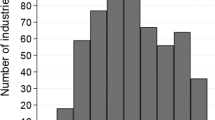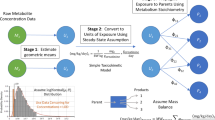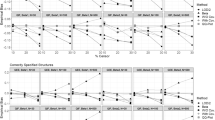Abstract
Creatinine measurements can be used to standardize urinary pesticide concentrations and to estimate “completeness” of urine collections. Published statistical models exist to predict 24-h creatinine, but many were developed assuming independence among observations. Using correlated repeated measurement data collected from an occupational cohort, the objectives were to create a predictive model for 24-h urinary creatinine and to compare the predictive capability of this model to earlier published models. Using a mixed-model methodology, the appropriate covariance structure was identified and utilized to model the measurements. A backwards elimination model building technique applied to the model building data set (110 adult male subjects and 457 creatinine values) yielded a final model that included variables for body mass index (BMI), height, diabetes, allergies, medical conditions that affect kidney function, use of creatine supplements, and anti-inflammatory medications. Using an external model validation data set (21 adult male subjects’ creatinine values, n=91 observations from a total of 275) the predictive performance of the model was evaluated using the mean square prediction error (MSPR) and the Pearson's correlation coefficient (r); its performance was better (MSPR=279184, r=0.43) than any of the earlier models investigated (MSPR: range 658860–393139; r, range 0.18–0.38). In conclusion, the use of a covariance structure that allowed repeated measurements for any one individual to be correlated, improved the predictive performance. For purposes of incomplete urine sample identification in observational studies, it is necessary to collect information in addition to age, gender, and BMI, which are typically used in these settings.
This is a preview of subscription content, access via your institution
Access options
Subscribe to this journal
Receive 6 print issues and online access
$259.00 per year
only $43.17 per issue
Buy this article
- Purchase on Springer Link
- Instant access to full article PDF
Prices may be subject to local taxes which are calculated during checkout



Similar content being viewed by others
References
Anderson D.R., Sweeney D.J., and Williams T.A. Statistics for Business and Economics, 5th edn. West Publishing Company, St. Paul, MN, 1993.
Burnham K.P., and Anderson D.R. Model Selection and Inference: A Practical Information-Theoretic Approach. Springer-Verlag, New York, 1998.
Guerin L., and Stroup W. A Simulation Study to evaluate PROC MIXED analysis of repeated measures data. In: Proceedings of the Twelfth Annual Conference on Applied Statistics in Agriculture. Kansas State University, Manhattan, 2000.
Harris S.A., Purdham J.T., Corey P.N., and Sass-Kortsak A.M. An evaluation of 24-h urinary creatinine excretion for use in identification of incomplete urine collections and adjustment of absorbed dose of pesticides. Am Ind Hyg Assoc J 2000: 61 (5): 649–657.
Harris S.A. Pesticide dose monitoring in turf applicators. Final Report. National Institute for Occupational Safety and Health Centers for Disease Control and Prevention. PA 99-143: Occupational Safety and Health Research. No. R01OH04084. Oct. 31, 2006, 1–246.
Harris S.A., and Wells K.M. Dose prediction modeling for epidemiologic assessment of pesticide exposure risks in occupational cohorts. In: Krieger R.I., Ragsdale N., and Seiber J.N., (Eds.). Assessing Exposures and Reducing Risks to People from the Use of Pesticides, ASC Symposium Series 951 American Chemical Society, Washington, DC, 2007 pp. 87–200.
Henderson C.R. Applications of Linear Models in Animal Breeding. University of Guelph Press, Guelph, 1984.
Heymsfield S.B., Artega C., McManus C., Smith J., and Moffitt S. Measurement of muscle mass in humans: validity of the 24-h creatinine method. Am J Clin Nutr 1983: 37 (3): 478–494.
Jennrich R.I., and Schluchter M.D. Unbalanced repeated-measures models with structured covariance matrices. Biometrics 1986: 42 (4): 805–820.
Jones C.H., Newstead C.G., and Will E.J. Estimation of total daily creatinine clearance in CAPD from serum creatinine concentration. Perit Dial Int 1997: 17 (3): 250–254.
Johnson C.A., Levey A.S., Coresh J., Levin A., Lau J., and Eknoyan G. Clinical practice guidelines for chronic kidney disease in adults: Part II. Glomerular filtration rate, proteinuria, and other markers. Am Fam Phys 2004: 70 (6): 1091–1097.
Kamata K., and Tochikubo O. Estimation of 24-h urinary sodium excretion using lean body mass and overnight urine collected by a pipe-sampling method. J Hypertens 2002: 20 (11): 2191–2197.
Katzung B.G. Basic & Clinical Pharmacology, 9th edn. Lange Medical Books/McGraw-Hill, New York, 1989.
Kawasaki T., Uezono K., Itoh K., and Ueno M. Prediction of 24-h urinary creatinine excretion from age, body weight and height of an individual and its application. Nippon Koshu Eisei Zasshi 1991: 38 (8): 567–574 (in Japanese).
Kenward M.G., and Roger J.H. Small sample inference for fixed effects from restricted maximum likelihood. Biometrics 1997: 53: 983–997.
Kesteloot H.E., and Joossens J.V. Relationship between dietary protein intake and serum urea, uric acid and creatinine, and 24-H urinary creatinine excretion: The BIRNH Study. J Am Coll Nutr 1993: 12 (1): 42–46.
Khattree R., and Naik D.N. Applied Multivariate Statistics with SAS Software, 2nd edn. SAS Institute Inc., Cary, NC, 1999.
Kutner M.H., Nachtsheim C.J., Neter J., and Li W. Applied Linear Statistical Models, 5th edn. McGraw-Hill Irwin, Boston, 2005.
Letteri J.M., Asad S.N., Caselnova R., Ellis K.J., and Cohn S.H. Creatinine excretion and total body potassium in renal failure. Clin Nephrol 1975: 4 (2): 58–61.
Littell R.C., Milliken G.A., Stroup W.W., Wolfinger R.D., and Schabenberger O. SAS for Mixed Models, 2nd edn. SAS Institute Inc., Cary, NC, 2006.
Moriyama M., Saito H., Nakano A., Funaki S., and Kojima S. Estimation of urinary 24-hr creatinine excretion by body size and dietary protein level: a field survey based on seasonally repeated measurements for residents living in Akita, Japan. Tohuku J Exp Med 1988: 156: 55–63.
Penie J.B., Porben S.S., and Silverio Y.D.C. Local reference intervals for the excretion of creatinine in urine for an adult population. Nutr Hosp 2003: 18: 65–75 (in Spanish).
Poortmans J.R., Auquier H., Renaut V., Durussel A., Saugy M., and Brisson G.R. Effect of short-term creatine supplementation on renal responses in men. Eur J Appl Physiol 1997: 76 (6): 566–567.
Proctor D.N., O’Brien P.C., Atkinson E.J., and Nair K.S. Comparison of techniques to estimate total body skeletal mass in people of different age groups. Am J Physiol Endocrinol Metab 1999: 277 (3) Part 1 (September): E489–E495.
SAS Institute Inc.. SAS Software for Windows, Release 9.1.3 Service Pack 3 SAS Institute Inc., Cary, NC, 2003.
Schabenberger O. Mixed model influence diagnostics. In: Proceedings of the Twenty-ninth Annual SAS Users Group International Conference. SAS Institute Inc., Cary, NC, 2004, 1–17.
Tanaka T., Okamura T., and Miura K., et al. A simple method to estimate populational 24-h urinary sodium and potassium excretion using a casual urine specimen. J Hum Hypertens 2002: 16 (2): 97–103.
Turner W.J., and Cohn S. Total Body potassium and 24-h creatinine excretion in healthy males. Clin Pharmacol Ther 1975: 18 (4): 405–412.
Vittinghoff E., Glidden D.V., Shiboski S.C., and McCulloch C.E. Regression Methods in Biostatistics: Linear, Logistic, Survival, and Repeated Measures Models. Springer, New York, 2005.
Vonesh E.F., and Chinchilli V.M. Linear and Nonlinear Models for the Analysis of Repeated Measurements. Marcel Dekker Inc., New York, 1997.
Welle S., Thornton C., Totterman S., and Forbes G. Utility of creatinine excretion in body composition studies of healthy men and women older than 60-y. Am J Clin Nutr 1996: 63: 151–156.
Wolfinger R.D. Covariance structure selection in general mixed models. Communications in Statistics — Simulation and Computation 1993: 22 (3): 1079–1106.
Acknowledgements
This work was funded by a grant from CDC/NIOSH, PA-99-143, Occupational Safety and Health Research, R01 OH004084. We acknowledge the contribution of individuals involved in the project described, including: Kirk Hurto and Chris Forth (TruGreen Chemlawn); Kristen Wells, Ricky Ciner, Donna Huggins, Diane Bishop and Charlene Crawley (VCU); and, of course, the motivated and cooperative volunteers.
Author information
Authors and Affiliations
Corresponding author
Ethics declarations
Competing interests
The authors declare no conflict of interest.
Appendices
Appendix A
Details of the mixed model
The mixed model in matrix notation (Khattree and Naik, 1999) can be written as:

where: i=1, 2,…., n. n=number of subjects; pi=number of measurements made on the ith subject; q=number of fixed effects; r=number of random effects; yi=the pi × 1 vector of repeated measures on the ith subject; Xi=the known pi × q matrix of constants that describe the structure of the study with respect to fixed effects (including treatment design, regression explanatory or predictor variables) for the ith subject (Littell et al., 2006). β=the fixed q × 1 vector of unknown parameters; Zi=the known pi × r matrix of constants that describe the study's structure with regard to random effects (including blocking design and explanatory variables in random coefficient designs) for the ith subject (Littell et al., 2006). νi=the r × 1 vector of random effects for the ith subject; ɛi=the pi × 1 vector of random errors for the ith subject; with expected values, variances, and covariances given by (Khattree and Naik, 1999):
E( νi )=0; Var( νi )=σ2G1 (where G1 is the covariance matrix of the random effects)
E( ɛi )=0; Var( ɛi)=σ2Ri (where Ri is the covariance matrix of the repeated measures on subject i)
E(ν)=0; E( ɛ )=0;
For i≠j : Cov ( νi, νj )=0; Cov ( ɛi, ɛj )=0; Cov ( νi, ɛj )=0;
Cov ( νi, ɛi )=0; Cov (ν, ɛ)=0

Owing to the random vectors ν and ɛ in this mixed model, there are two possible distributions to consider — the conditional distribution of (y ∣ ν) and the marginal distribution of y as shown here (Littell et al., 2006):


By using the mixed model approach, it is possible to obtain insight into the within-subject variation, over time, for the total 24-h urinary creatinine level. The within-subject variation for subject i would be contained in the Ri covariance matrix referenced in the mixed model description shown above. The potential explanatory factors of age, height, weight, BMI, etc. are placed in the matrix of constants that describe the structure of the study with respect to fixed effects (i.e., the Xi matrix). No explanatory factors are placed in the model in the matrix of constants that describe the study's structure with regard to random effects (i.e., the matrix Zi =0). Hence, for this study's model, ν is a zero vector, G is a zero matrix, no random effects will be estimated, and the variation will be modeled through the R matrix.
Appendix B
Estimation of fixed and random effects in the mixed model when using REML
As noted earlier, for the mixed model, E(y)=X β and Var(y)=σ2[ZGZ′+R]. The Estimated Best Linear Unbiased Estimator (EBLUE) of the fixed effects ( ) and the Estimated Best Linear Unbiased Predictor (EBLUP) of the random effects (
) and the Estimated Best Linear Unbiased Predictor (EBLUP) of the random effects ( ) can be obtained by letting V=ZGZ′+R, “plugging in” the REML estimates of the G and R covariance matrices (
) can be obtained by letting V=ZGZ′+R, “plugging in” the REML estimates of the G and R covariance matrices ( and
and  respectively) into V to get
respectively) into V to get  , and then solving this system of mixed model equations (Henderson, 1984; Littell et al., 2006) shown here:
, and then solving this system of mixed model equations (Henderson, 1984; Littell et al., 2006) shown here:

The solutions (Khattree and Naik, 1999) are:

Appendix C
Rights and permissions
About this article
Cite this article
Kroos, D., Mays, J. & Harris, S. A model to predict 24-h urinary creatinine using repeated measurements in an occupational cohort study. J Expo Sci Environ Epidemiol 20, 516–525 (2010). https://doi.org/10.1038/jes.2009.40
Received:
Accepted:
Published:
Issue Date:
DOI: https://doi.org/10.1038/jes.2009.40
Keywords
This article is cited by
-
Numerical algorithms for corner-modified symmetric Toeplitz linear system with applications to image encryption and decryption
Journal of Applied Mathematics and Computing (2023)



